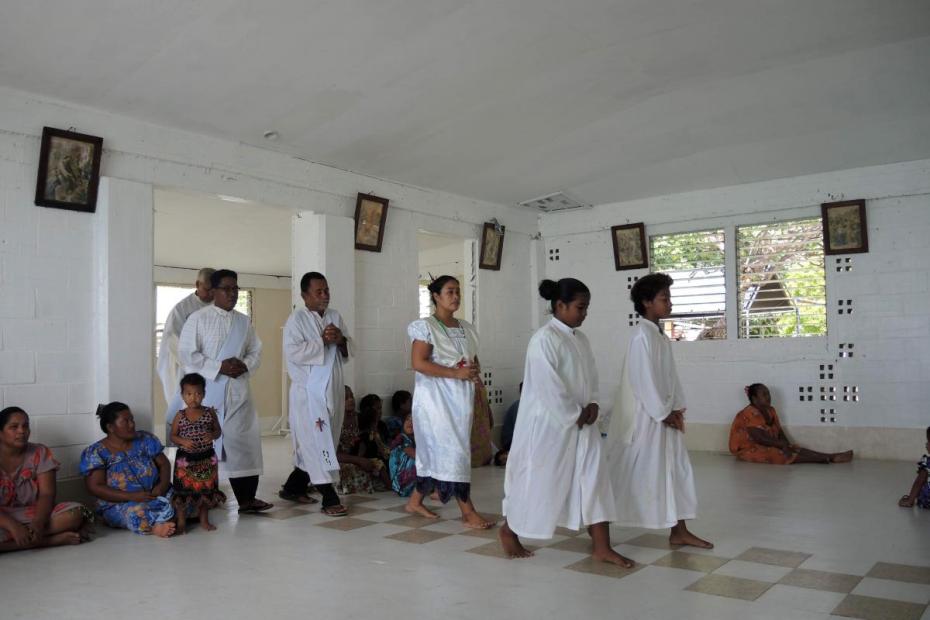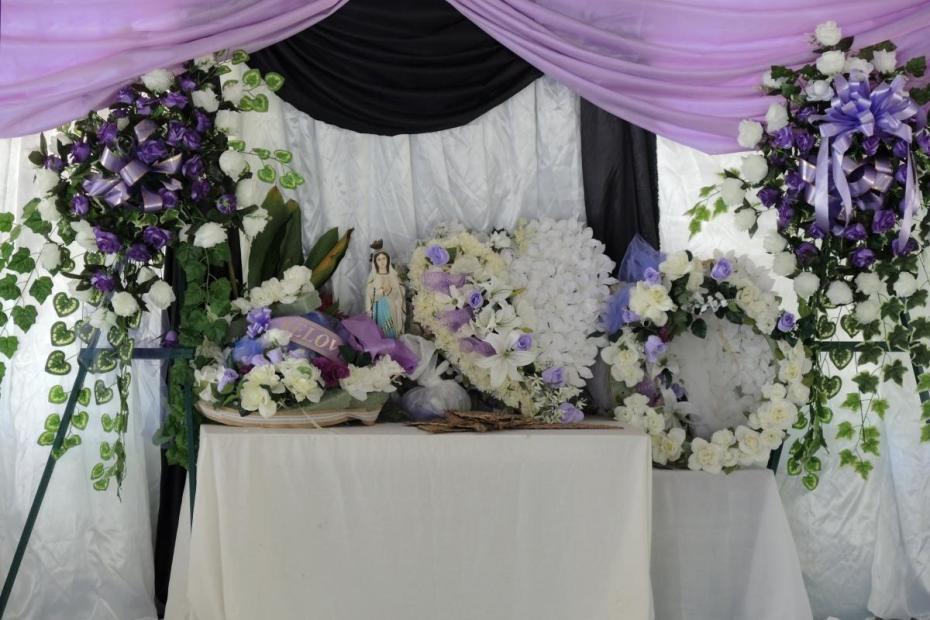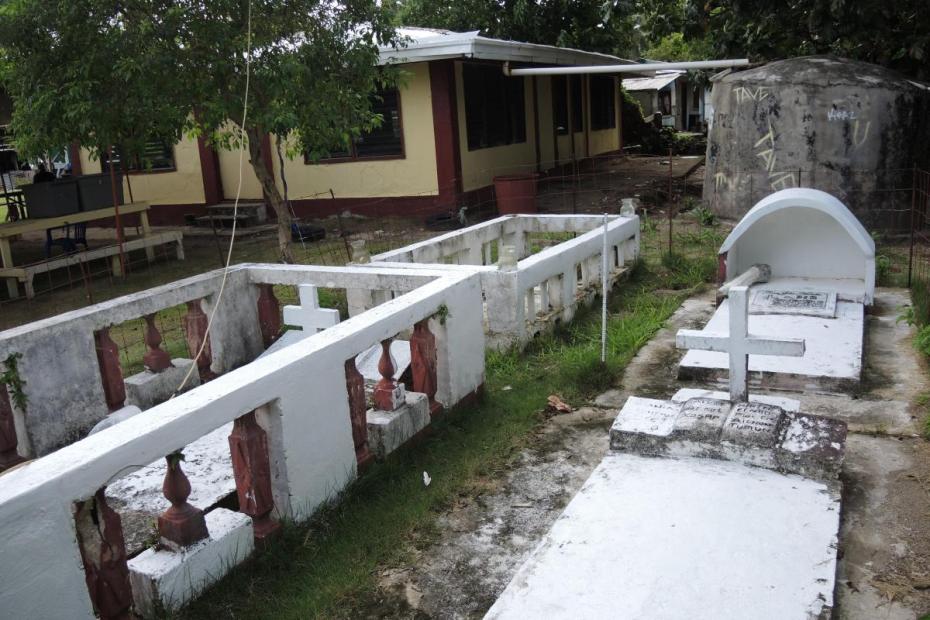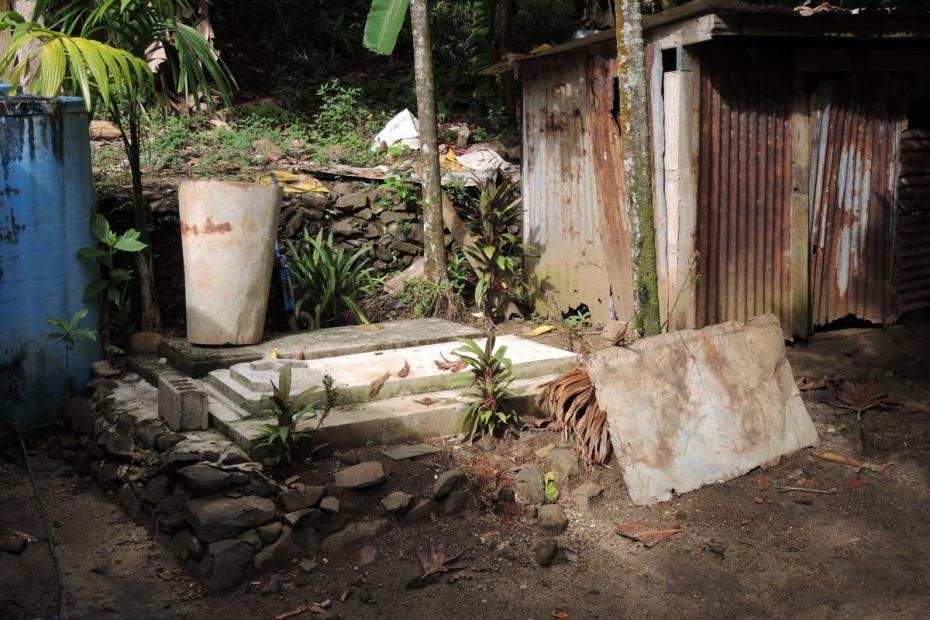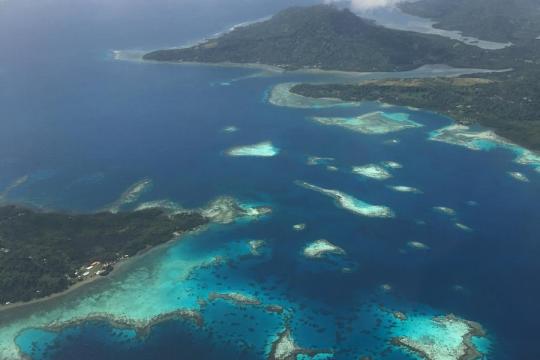Respect for the dead, and adherence to rituals to properly mourn them, is a tremendously important aspect of Chuukese culture, an aspect that predates Western encounters.1 It helps not only to grieve and show respect for the dead, and to pray for their well-being, but also, interviewees reported, to shape the family and community’s understanding of itself and to help it plan for a better future. In the Chuuk Lagoon, the dead are often buried very close to the house, rather than in separate cemeteries. Funerals are major, multi-night events organized and attended by the whole community, and by relatives from abroad if possible. In sharp contrast to daily life, where emotional display is radically downplayed, traditional funerals are “culturally orchestrated in their emotional display.”2
In accordance with the lineage systems that have long defined life in Chuuk, the dead are typically brought back to be buried on the land where they were born, the land of their matrilineage. On Fono and Weno, they are buried not long after death, rather than at the end of the mourning period. In case of the memorial services at Fono featured on this page, the deceased had been flown back from Hawaii, and a few family members came back with his body. Mourners came in from other islands as well.3
The traditional form of mourning—at least what interviewees and other sources regard as traditional—entailed several days of waiting for the souls of the departed to finally leave. Pre-colonial Chuuk was a place where the spirits of the dead were very much a force in people’s imaginations, but it is not clear to what degree that’s true a century later. Accounts vary, but one interviewee, in her 60s, recounted that as a child she heard elders talk about a belief that spirits come up from the grave in the form of smoke and make their way to the water, where they finally depart.4 Anthropologist Ward Goodenough observed in the 1960s that while most traditional beliefs around pre-Christian spirits had disappeared, “concern with the spirits of deceased relatives… continued to be strong.”5 Dobbin reported that in the Chuuk Lagoon, possession still happens occasionally at the time of mourning and burial. “People are still afraid of bad ghosts or spirits, and many still report seeing them. The three- or four-day period after burial is still observed, as the ancestors continue to be important in the belief and practice of the people.”6 My interviewee described what she heard about spirits as a child as a now-discontinued belief, but it seems to have one impact in terms of how long the mourning period lasts. Protestants still celebrate three nights of mourning. Catholics, though, borrowing from the Rosary novena tradition, extend it to nine nights.
Decades ago, Francis X. Hezel, S.J., reports, to hear the wailing of women was a “bone chilling” experience. Men were traditionally impassive at funerals (as they were and are expected to be from day to day), sitting outside apart from the rituals, but women traditionally wailed as they lay around the corpse on mats. This has changed to some extent, he says, and it was not described by any of my own interviewees, but Hezel indicates that it continues on some islands.7
During the first three days of mourning in particular, one interviewee recounted, people may not even shower, and they speak quietly. They come together in the house of the dead person. Friends “bring pounded breadfruit, fish, and coconut, to visit the family… and also say something to the family.” “We pray for the soul of the loved ones.” Prayers continue through the novena, with an evening Rosary. “It’s a custom to, when the last day [comes], everybody—there’s a Chuukese word for it—they get up and say how they feel… People take the occasion to speak about grievances and hurts done to each other, to apologize.”
On Fono, one woman told me that she had been preparing her speech, which would include reciting some scripture verses that she remembers. She and other family members would make a speech “about how they promise to improve their lives and make the family stronger.” As is discussed in greater depth elsewhere on this site, these reconciliation speech rituals are not about reconciling with potentially malevolent spirits, but are very much for the living. Recalling one she had recently been part of, one woman said bluntly, “It wasn't for the sake of the spirits, it was for the sake of the community.” Funeral reconciliation “really brings people together,” another said. People take turns speaking, not about the qualities of the deceased, but “about working together… the speeches are more focused on re-affirming or relationship, and even some will speak about getting closer to God. Some will just talk about ways to keep our family together.”
Normally after all of this, there is a memorial Mass.
- 1An 18th-century account by Jesuit missionary Juan Antonio Cantova, based on descriptions of Caroline Islanders who had ended up on Guam, describes a religious system populated by various groups of spirits, including ancestral spirits and good and evil deities, and recounts creation legends from various islands, but noted that the islands did were lacking in “shrines, idols, sacrifices and other external cultic forms,” comparable to those he knew of elsewhere. But he went on to single out the burial customs of islanders as an exception. While he may have missed a good deal about religiosity there, his account signaled what seems to be an enduring factor of Chuukese life, the salience of funerals as especially important religious rituals. Francis X. Hezel, S.J., The First Taint of Civilization: A History of the Caroline and Marshall Islands in Pre-Colonial Days, 1521–1885 (Honolulu: University of Hawai’i Press, 1983), 54.
- 2Francis X. Hezel, S.J., Making Sense of Micronesia: the Logic of Pacific Island Culture (Honolulu: University of Hawai’i, 2013), 133-4.
- 3The descriptions here on funerals depend on interviews conducted in 2017 and 2018 among Chuukese in Guam and on Weno and Fono. While I was able to speak to family members in Fono in the course of a funeral, I was not invited to be there for the ritual.
- 4Also see the section titled “Spirits of the Dead” in Francis X. Hezel, S.J.’s “Congries of Spirits,” http://www.micsem.org/pubs/articles/religion/frames/congspiritsfr.htm.
- 5Ward Goodenough, Under Heaven's Brow: Pre-Christian Religious Tradition in Chuuk (Philadelphia: American Philosophical Society, 2002), xviii.
- 6Jay D. Dobbin, Summoning the Powers Beyond: Traditional Religions in Micronesia (Honolulu: University of Hawaiʻi Press, 2011), 37.
- 7Hezel, Making Sense of Micronesia, 133-4.
